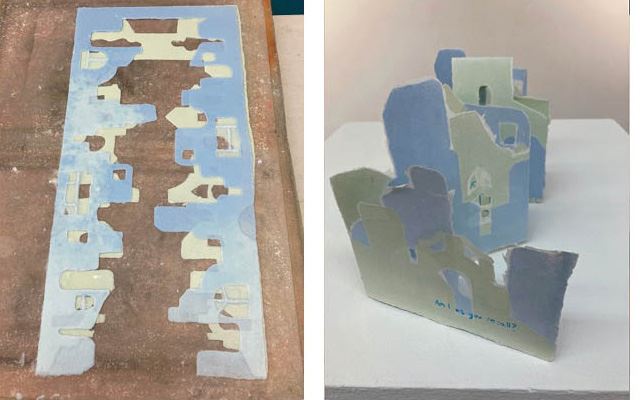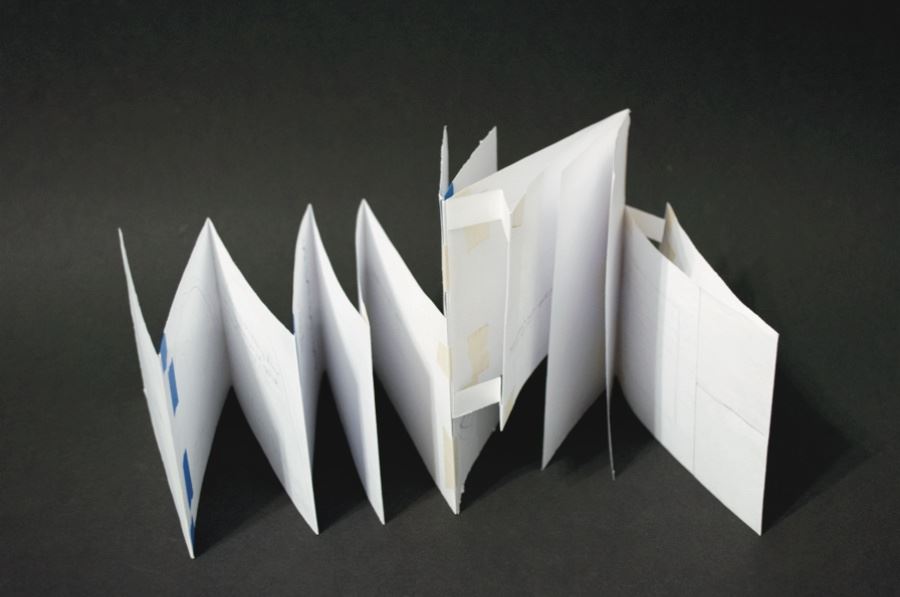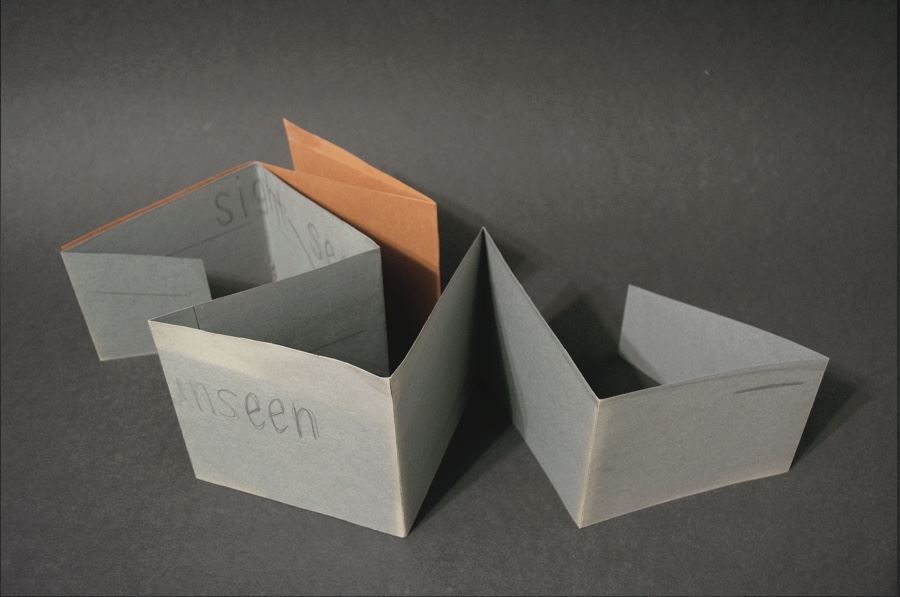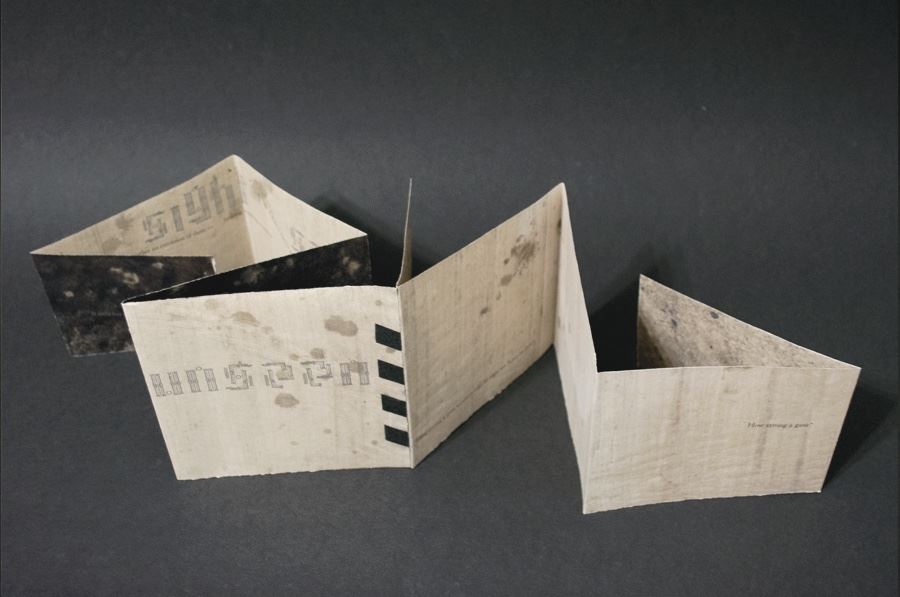Here’s a note from my planner: Three two-sided press sheets (each three-color) equals 18 print runs over six days. With an April 8th print deadline, plates should be made by March 15th, films must be printed by March 10th, and files completed by March 5th. Final deadline for imagery: February 28th.
Spontaneity is not a hallmark of book arts. Although I’ve never met a book artist who likes rulers, it’s imperative to calculate borders, plan impositions, and set timelines. There is a range, of course—as a UArts student working with visiting artist Sarah Matthews and master printer Amanda D’Amico in the Borowsky Center, my cohort was able to complete an entire book in one day, a strong contrast to the often months or years-long process of development. But even Sarah Matthews’s quick collaborative book required a set of decisions about edition size and layout and preparations like pre-carved stamps to set the stage.
Even so, the necessity of structure does not make book arts rigid. For book arts, planning and improvisation are dance partners. I see three significant opportunities for creativity and playfulness in the book arts process: learning, iteration, and moments of action.
Book arts is a field of continuous education as a result of its breadth of mediums. As an acolyte of books, you never finish studying niche or historical structures, trying unusual print methods, or testing new paper fibers. I’ve observed that the practice of collecting techniques is a great source of inspiration and challenge: “What narrative suits this structure? What happens if I fold this way?” I believe this is why the book arts field has such a robust workshop circuit: learning is the flashpoint that sets long-term structured projects in motion. For me, trying a simple pants fold led to a book formed entirely from one shaped sheet of handmade paper.

Bryn Ziegler, Return, Recall, 2022, handmade paper, 6 in x 6 in x .5 in,, Philadelphia, Pennsylvania.
For my colleague, Grace Johnson, mastering the drum leaf inspired a laminated board book that exploits the binding’s ability to open entirely flat.

Grace Johnson, Constructure, 2022, offset lithography, 4.5 in x 9.25 in x 0.5 in, Philadelphia, Pennsylvania.
Mock-ups, the practice of testing book format through one-off iterations, are a natural continuation of learning exploration. Mock-ups are an opportunity to work directly without consequences. They’re also where book artists first make their ideas physical, exercise unconventional thought, and frequently innovate on the book format. Mock-ups are the strongest illustration of direct play in bookmaking and a significant point of intersection between creativity and planning. Erica Honson’s book If Shoeprints In Concrete are Urban Fossils is an excellent example—you can see their creative process in the shift from the first model, a fantastical amalgam of folding structures and fluctuating page sizes, to the second, a more measured object acting as a tool to work out the concrete (pardon the pun) aspects of the book. The finished piece, made from shaped sheets of handmade paper and letterpress printed, required enormous forethought and precision. But, like many artist books, it started with iterative, freeform exploration.



Erica Honson, If Shoeprints in Concrete are Urban Fossils, 2021, handmade paper and letterpress techniques, Philadelphia, Pennsylvania.
Finally, we have moments of action. After extensive preparation, it’s time to print and bind. And therefore time to trust yourself to make the right moment-by-moment creative decisions for your project. No matter how calibrated the plan, there is always an unpredictable element: the artist…and sometimes studio humidity, press temperament, or any number of factors. Whether by re-mixing an ink, shifting an image two picas, or ordering a custom stamp to disguise a missing page number (not that I’m speaking from experience), the lengthy planning process culminates in an exhilarating spate of creative problem-solving.
I often speculate about what unites us as printers and bookbinders. To print, you must cultivate the ability to think in reverse, not only by reversing your imagery but also by starting from the intangible end result and working backwards. Who does that appeal to? My theory is that the greatest creativity is inspired by imposing structure. Limitations encourage inventive solutions, prompting artists to push the boundaries of their ingenuity. It’s hard to think outside the box without knowing where the borders are. As book artists, it’s essential to consider how the inherent structure of book arts is a draw for the field. It isn’t a foil to the playful aspects of the process; it’s a prompt for them.
Bryn Ziegler is a Philadelphia-based artist and educator specializing in intricate narrative books. She holds an MFA in Book Arts and Printmaking from University of the Arts. Bryn’s artistic practice embraces both contemporary digital techniques and profoundly traditional craft, giving her a dynamic perspective on the development of books today.

